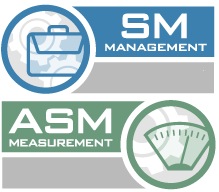SM/ASM 2001 - Software Management & Applications of Software Measurement

PRESENTATIONS
|
A Disciplined Approach to High Velocity Software Development
When faced with the challenge of shortening delivery cycles, the old economy manufacturing companies utilized disciplined quality techniques to reduce scrap and rework and improve productivity. Software developers in the new economy face a similar challenge to accelerate development to meet critical time-to-market business goals brought about by the Internet. Unfortunately, many are abandoning disciplined methods in lieu of a risky "hack and test" approach with potential disastrous consequences for customers and developers. |
|
|
A Force for Change-Using Resistance Positively
When we try to improve our organizations, we inevitably encounter resistance. This presentation describes how to turn resistance into a resource. Whatever else it may be, resistance is information about the people we are asking to change; about the environment in which the change will happen; about the changes we recommend; and ultimately, about ourselves. Learn ways to tap into that information to turn resistance into a resource for creating lasting improvement. |

Dale Emery, Sun Microsystems |
|
A Metrics Dashboard for IT Project Reporting
Tom Olenick described the activities performed to design, develop, deploy, and maintain a Project Management Metrics Dashboard across the IT organization of a major Chicago-based securities organization. Learn how this metrics dashboard was used to facilitate project status tracking for IT management and to provide a basis for improving the efficiencies of software development activities and estimation. |
|
|
A New Approach for Estimating in e-Business Development
In order to control the costs and schedules of new eBusiness development projects, a revolution in estimation and the software lifecycle must take place. Learn how the Fixed-Time/Fixed-Price estimation model of delivering software provides you with more business benefit as it reduces the new development environment to duplicable, repeatable processes and more accurate costs and time projections. Discover how this new model can increase the delivery of projects on time-and on budget-by a factor of sixty to seventy percent! |
|
|
A Practical Framework for Software Measurement
Measurement is often defined in terms of collecting data, distinguishing it from analysis-the interpretation and use of data. Clearly, the collection of data must be driven by its intended use. In this presentation, David Card presents a framework that treats measurement and analysis as an integrated process. Discover the four basic components of this framework, and learn how to use the framework to ensure that all-important perspectives and potential users of measurement are considered in the measurement planning process. |
|
|
B2B and B2C Software Project Management—So What's Different?
Learn how to understand and address the unique and not so unique aspects of Internet-based business-to-consumer (B2C) and business-to-business (B2B) project development. Based on three case studies used to illustrate the important aspects of Internet project development, you will cover the full project lifecycle--from inception to launch--highlighting key principles and practices along the way. |
|
|
Better Testing-Worse Quality?
Many organizations react to quality issues encountered after shipping a product by renewing their emphasis on testing. The logic is that better testing would have resulted in better software. Ironically, focusing on testing can cause worse quality. In this discussion, Elisabeth Hendrickson provides real-world examples of when better testing has resulted in worse quality and how to turn around the downward spiral. |

Elisabeth Hendrickson, Quality Tree Software, Inc. |
|
Buffers and Risk: Critical Chain Project Management
Critical Chain Project Management uses statistical process control to more clearly define the relationships between tasks and the project end date by using buffers to represent process variation in project tasks. This paper shows how integrating effective statistical process control with the use of function points and standard processes can dramatically improve your ability to plan and control projects. Using examples based on real-life experience, it provides a simple method for controlling variation and risk. |
|
|
Deploying Software Configuration Management-A Case History
Bill Buie presents a picture of what software configuration management looks like--and what it took to get there--in a real-life organization. Learn how one company built an infrastructure to support configuration management, including the tools and processes required. Lessons learned in deployment will be discussed, including identifying the right champions, incremental deployment, and the growth opportunity in tools. |
|
|
Effort Tracking Made Easy
Tracking effort is often a difficult cultural change to implement. Projects working toward Capability Maturity Model (CMM) Level two behaviors struggle with effort tracking for many reasons, including tool restrictions, resistance, and complicated processes. Lynn Cole shares insight and techniques that she has both successfully implemented and seen implemented by others. Discover the simple steps that you can take to start capturing and using effort data about a project. |
|


